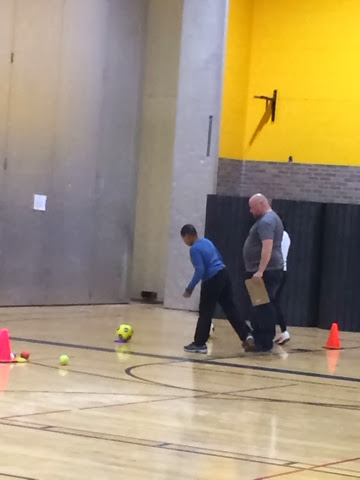I have been associated with AWA for over two years now. With these experiences, let me explain to you how this program is completely unique and how your child could benefit from joining the program.
What is Athletes with Autism?
Athletes with Autism is a Detroit-based sports program that is trying to promote fitness, motor skills, socialization and independence in children with Autism. Athletes with Autism provides 3 different recreational sessions per year. Two sports/skill related sessions in the Fall and Winter and a swimming session in the Spring. All of these sessions take place at Wayne State University.
Meet the Volunteers
The athletes are put into small groups of 3-5 with a 1:1 ratio of volunteers to athletes. Athletes are able to work in a one-to-one environment with a volunteer and build a strong bond with that person. A majority of the volunteers at Athletes with Autism are Physical Education college students or Speech Pathologist graduate students. This makes for a great learning environment for the athlete. Not only is the athlete receiving invaluable motor skills training, but they are working in a one-on-one setting with future professionals who are building upon the athlete's speech abilities. The volunteers for this program make for an unique group of future educators that can deliver a wide variety of important skills that a child with Autism would benefit from for a lifetime.
Incorporation of Technology
One of the most amazing aspects of the program is the AWA app that they use with the children. The AWA app contains social stories, visual schedule, a timer, visual/video representations of motor skills, and a reward system.
- The social stories/visual schedules are used throughout the sessions and are specially created to help relieve anxiety and tell the student what is going to happen next.
- The timer is used for students that may need a visual to help reduce anxiety. It can be used before a transition or to track how long a student can have a break/reward.
- The visual/video representations of motor skills are used to show a visually stimulating video on how to correctly carry out a motor skill.
- The reward system will shows the students a visual representation of how many tasks they must perform before they receive a reward.
Structure of the Sessions
Every session starts as a large group coming together and reading a welcome/warm-up activity social story on a projector, then the group engages in a warm-up activity. The groups then go into their separate smaller groups. The speech pathologist in each group conducts a skills practice social story on the iPad. The children engage in the skills practice which can range from practicing one's basketball dribbling to learning the backstroke. After the timer goes off, athletes come back together in their small groups and read a game social story on the iPad. The athletes will then play in a game that was specially designed for their unique needs. After they have finished the game, they will go back into the large group setting and read a good bye social story as a group.
Personal Experience:
From my own experiences at AWA, I found that it was a phenomenal experience. I gained a better insight for whom I was as an educator and as a person. It was one of my first experiences of working with children with disabilities in a physical education setting. I quickly found out that physical education for children with disabilities can be extremely beneficial for the child. Throughout each 8 week session (Spring is 6 weeks) I saw the children grow leaps and bounds from where they were when I first started working with them. They would interact more with their environments and with their peers. The children would also gain valuable motor/sports skills that they could use outside of the program to interact appropriately with their peers.
In graduate school, I conducted a study that looked for a link between the AWA program and social growth. We found that from the start to the end of a single session, athletes were tripling the amount of times they were initiating and reciprocating peer/coach interactions.
I would recommend this program to any parent who has a child with Autism and wants to see them develop more age-appropriate social/motor skills. With these skills that this program helps to ingrain, the child will become more independent and live a more fulfilling life.
Quote of the Day:
“If I could snap my fingers and be non-autistic, I would not.
Autism is part of what I am.”


